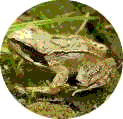
Life Cycles

| A life cycle describes all the major growth
stages which take place during an individual's lifetime. It includes the production of new
members of the species. As the name suggests, life cycles always follow a circular path,
arriving back at the same beginning. For example, tadpoles develop from frog spawn. They
grow into adults, passing through a series of stages. Adult frogs mate and the female frog
produces more frog spawn, from which new tadpoles develop. All living organisms reproduce and therefore have life cycles. These can take many different forms, although they usually follow the same general pattern.
|
||||
|
||||
|